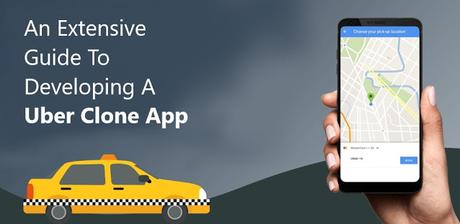
The word ‘taxi’ has become synonymous with the word ‘Uber.’ Such is the impact created by Uber in the taxi and transportation industry. People’s approach towards taxis has changed dramatically ever since this big player arrived at the picture. The market for on-demand apps is on the steep for over a decade now. Various services are offered by these apps nowadays. However, taxi services have always been the most prominent industry in the market.
With that being said, the ride-hailing industry is expected to grow at a CAGR of 14.8% between 2019 and 2023. Apps like Uber, Ola, etc., are pouring revenue from various sources. Emerging entrepreneurs can always venture into this vastly expanding market and establish their mark. In this blog, let’s take a look at different stages of Uber clone app development.
How does an app like Uber work?
Before venturing into app development, let’s take a look at the workflow of a taxi app,
Users register in the app through their social media handles after downloading the app.
By enabling their location, they can request nearby taxis after providing the necessary pickup and drop locations.
Drivers can accept user requests and reach the user destination through the in-app navigation facility.
After completing the ride, users pay for the service via any of the payment methods available in the app.
Both drivers and users can rate and share their ride experience in the form of ratings and reviews.
This is the usual workflow of any taxi app. Now that we know how ride-hailing apps work, we’ll dive straight into development.
What are the different stages involved in app development?
Stage 1: Knowing your target audience and market research
Your app should be focused on a group of people who need it very often. Although ride-hailing apps are generic, it is better to develop the app having a specific target audience in mind. For example, your target audience can be working professionals who need a cab. Invariably, they’ll need a taxi to work every day, leading to your app’s sustainability.
After identifying your target audience, you need to know their expectations. This can be achieved by doing a market study of your locality. The market study opens quality insights into the demands of the market. Moreover, you’ll get to know the flaws of the existing app, thereby preventing them from your app development. To produce a viable product in the market, extensive market research is highly essential.
Stage 2: App documentation and designing the UI/UX of the app
App documentation involves identifying the technical requirements of the app. Complete specification of the app, as to the team required to develop, the timeline required, etc., are identified in this stage. All these specifications are documented and followed during various stages of development.
After documenting, you begin to design the outline of the app. UI/UX greatly impacts the user experience. As a result, try to avoid complexity in the design. A simple, yet innovative app with a user-friendly interface can scale greater heights in the market.
Stage 3: Front-end development
Now comes the most crucial stage of app development: Front-end development. It involves integrating the features and functionalities of the app. Your app is shaped in this stage of app development. For an uber clone app, some of the key features include,
In-app navigation
Multiple payment options
In-app chat/call facilities
Fare estimator
Call masking
Ratings and reviews etc.
Make sure your app is unique and stands out from the rest of the lot. The more unique your app, the greater is the popularity.
Stage 4: Back-end development
For your app to sustain site traffic, you need to manage servers and databases effectively. This stage is highly essential to encrypt user and driver details securely. The privacy of the app depends on this back-end development. Even developing the admin panel comes under this stage. Moreover, there are various panels created to maintain and manage the app seamlessly. Some of them include,
Fleet management
Lost item management
Dispute management
Dispatcher management etc.
Stage 5: App deployment and support
After developing the app, you deploy your app across different platforms, including Android, iOS, etc. No app is defect-free in the world. Even after rigorous testing procedures, bugs occur in the app. You should have a support team ready to manage and fix these issues in the app. Moreover, you need to hear customer queries 24x7. This is possible only if you have an inbound support team ready to assist. Periodic updates, according to the latest market trends, are necessary to stay competitive in the market for an increased time-frame.
Summing up,
App development is a tedious task. Executing every stage according to the timeline, can significantly help in conserving the budget. The market is set to grow exponentially for years to come. With a well-developed best-in-class Uber app clone, you can reap revenues in this flourishing ride-hailing app market!
